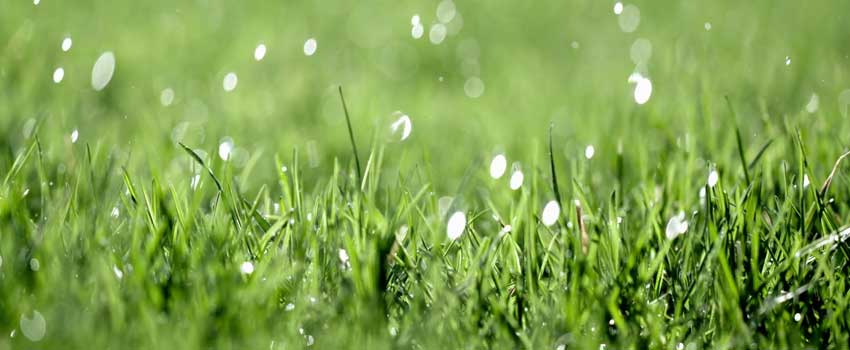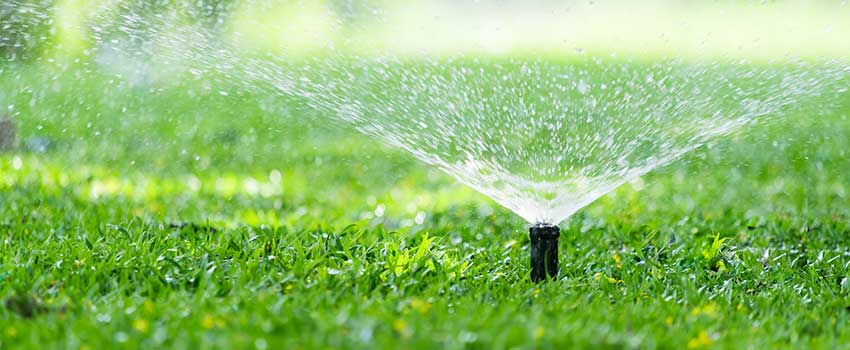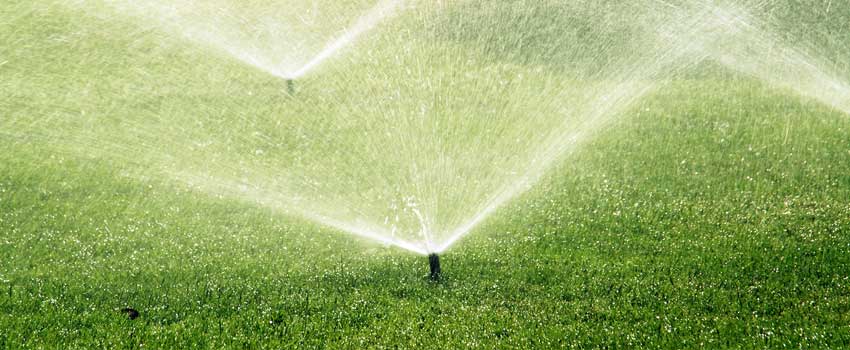Water is of vital importance to the overall well-being of plants, your lawn is no exception. To ensure your grass is healthy and vibrant it will need sunlight, nutrients and most importantly, water. Although, lawns may go through dormant states during the fall/winter season and can survive long bouts of drought and extreme weather, water still remains a necessity.
A healthy lawn is evident by thick, luscious grass that bounces back after being walked on and is a bright shade of green.
Knowing how much water your lawn needs might feel like bit of a guessing game.
More is not always better in this case.

If your lawn starts to look like this, it probably means it has been over watered.
Overwatering your lawn can cause damage to the grass and environment, leading to issues such as thatch, mold and fungus or runoff. It can also cause shallow rooted grass which will become dependant on daily watering instead of putting in the work to grow deeper roots in search of the good stuff.
On average, grass only needs about an inch (2.5 cm) per week. That’s about 10-15 minutes of watering.
Various factors may affect that amount such as, the amount of sunlight, heat, sloping, soil and grass variety, however; as a general rule, 1 inch should be sufficient.
Let nature assist in your watering needs. Take into account the amount of rainfall happening during the week.

Rain - earth's natural irrigation system
If you were planning on watering your grass in the morning and it down poured all night then to avoid overdoing it wait a couple of days.
In doubt? Check it out! If you are unsure as to whether or not your grass could you a good watering let your soil be your guide.
A quick poke test will let you know whether watering is required. Grab a screwdriver and press it into a section of soil. Relatively easy? Soil is still moist. Difficult/Can’t do it? The soil is dry and could use a drink! Grass roots only extend down approximately 6-8 inches, so anything lower than that would be a waste as the roots won’t be able to reach it.
The timing of the water is equally as important as the amount.

Watering your grass at the optimal time will ensure that the water is fully absorbed instead of wasting valuable resources.
Watering in the morning is recommended as it gives the grass amble time to dry and there is usually less heat, sunlight and wind to worry about. During the afternoon the sunlight could absorb the water too quickly, not allowing enough of it to seep into the soil and be available for the roots.
Also, temperatures are typically at their peak during the afternoon, so while that sun is blazing, most of the water your sprinkler is shooting out will be absorbed into the hot air before it ever hits a blade of grass, let alone the roots.
Evening watering may be tempting as for many of us our schedules don’t allow watering during the morning; however, the water droplets will sit on the blades of grass leaving it susceptible to fungus and diseases.
When deciding the best method for watering your lawn there are a couple of things you will water to consider.
Most homeowner resort to a sprinkler.

The two most common types of sprinklers are pulsating sprinklers or oscillating sprinklers. Traditional oscillating systems tend to be favourable to newly seeded lawns as they are less forceful and don’t run the risk of washing the seed away.
That being said the wind can end up blowing a lot of water around and you’ll find yourself watering the grass next door, however, missing parts of your own.

Oscillating sprinklers are increasing in popularity due to the efficient and resourceful method of shooting water horizontally across the lawn. Regardless of which method you choose, an even distribution of water over your whole property is more important than how it gets there.
Nowadays a lot of schedules are not conducive to remembering to turn on and off a sprinkler, let alone in the morning when most of us are getting ready for a busy day.
The option of an irrigation system allows for watering to be done with minimal, if any, help from the homeowner directly.
Timed watering will allow for a predetermined schedule to be set and ensure that your lawn never goes thirsty while you’re busy living your life. And with the option of a smart watering system, there are even apps that can keep you updated on the health and wellness of your lawn, letting you know moisture and nutrient levels. The user can monitor and run the irrigation system from their office or backyard.
If your property has a number of difficult to water areas you may need to consider an alternative watering method such as drip irrigation or an specialized systems.
Areas of concern might be highly sloped areas where the water runoff too quickly before it gets a chance to absorb. A system that slowly waters directly on the soil will allow for sufficient absorption.

Areas along the outside of the property or next to houses or buildings tend to get overlooked as well, and are at higher risk of being underwatered. A specifically designed system will ensure that all areas of your property receive not only water but the correct amounts.
Some areas that are heavily treed, or have gardens might not have the same water requirements as open grass areas. Irrigation systems are able to appropriate water each individual area making certain that all their watering needs are met.
Your lawn is your home's chance at great first impression. Increasing curb appeal and overall value to your property. Ensuring that it is well cared for and properly water doesn’t need to be a stressful or even time consuming endeavor.

With so many affordable options for irrigation and sprinkler systems there is no reason to have to worry about your lawns watering needs, leaving you more time to enjoy your summer, be it at home or away!

